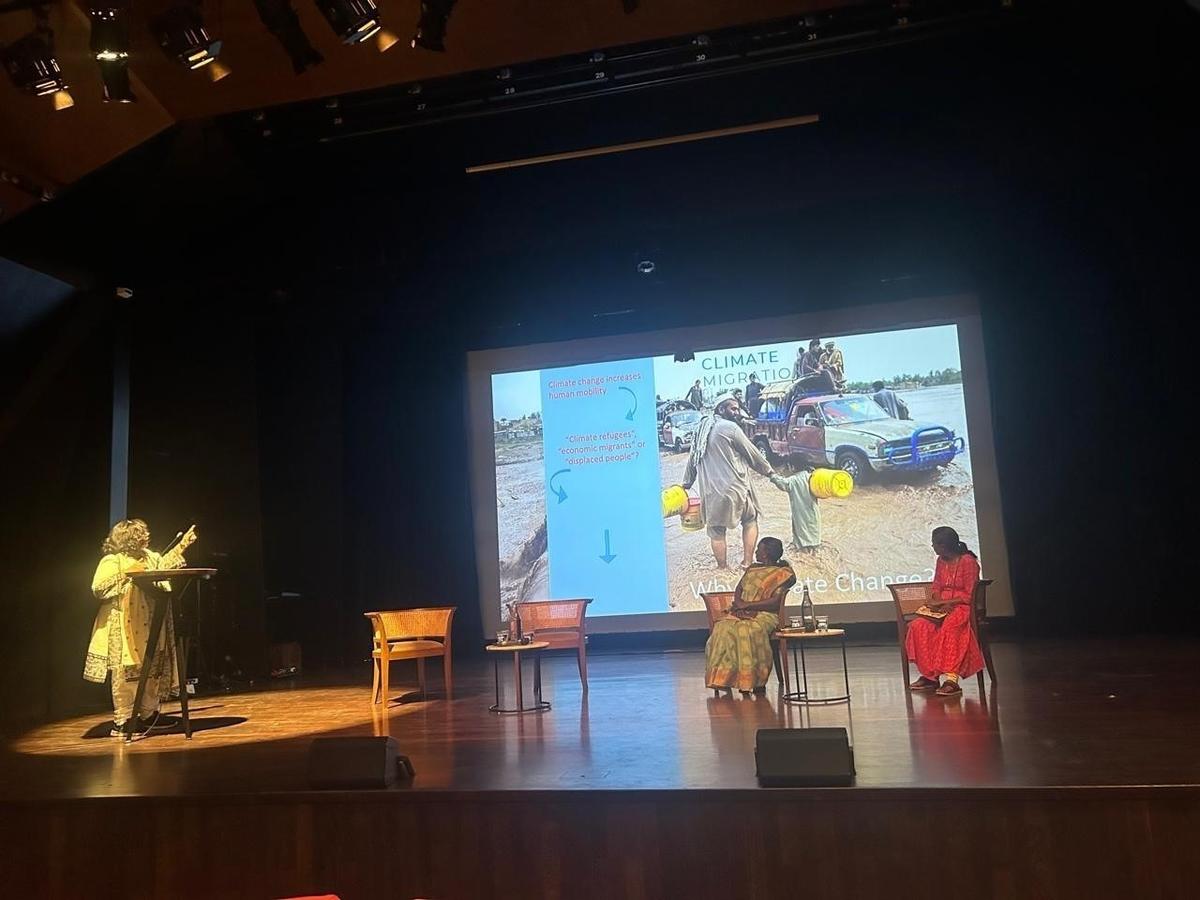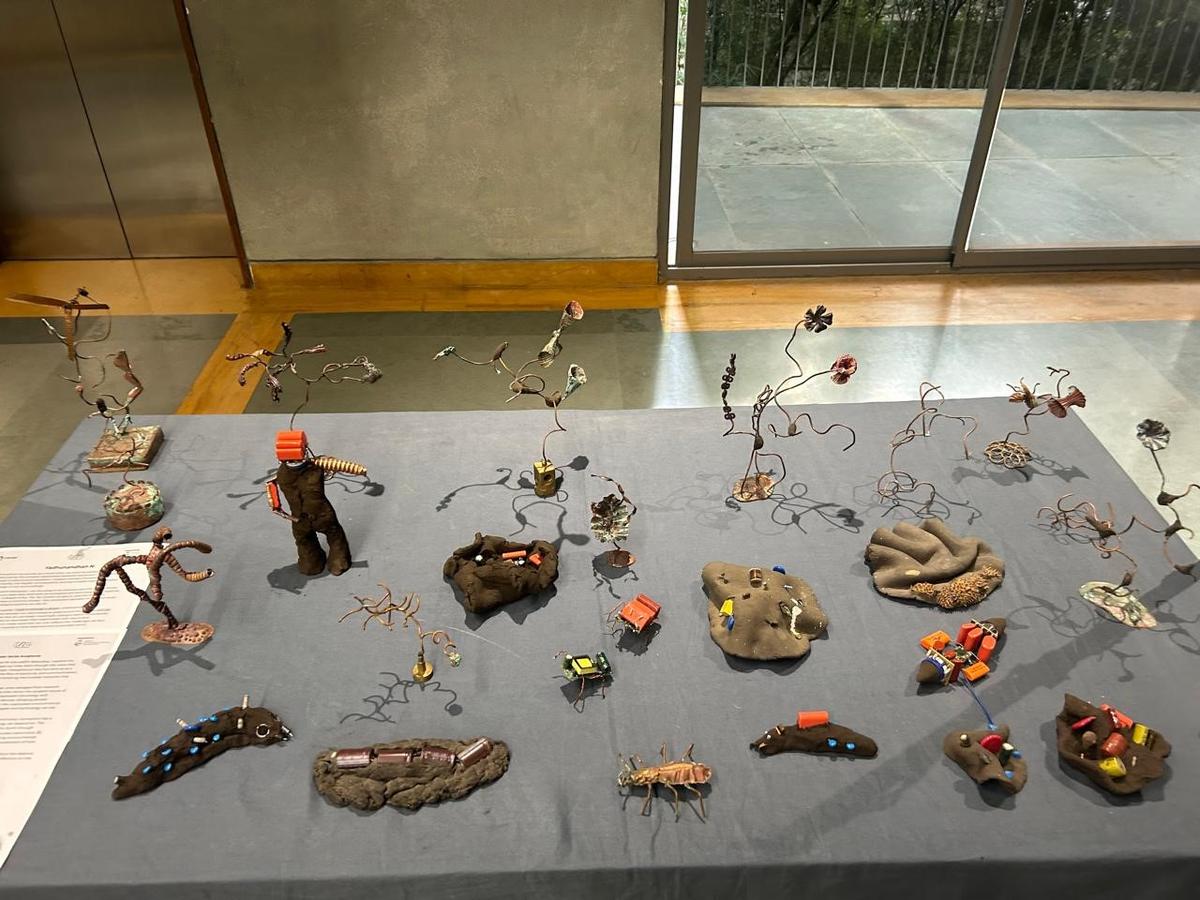(From left) Manjula Bharathy, Professor at Tata Institute of Social Sciences (TISS), Sheela Sanjeev Kumar, Climate Change Survivor, and Dhanyaja Santhosh, Climate Change Survivor.
| Photo Credit: SPECIAL ARRANGEMENT
In October last year, the Centre for Study of Science, Technology, and Policy (CSTEP), based out of Bengaluru, developed the eARTh Fellowship, an initiative to communicate to the public about climate change by merging art and science. The results of the first fellowship were showcased recently at Bangalore International Centre (BIC) in an exhibition hosted by the four selected fellows, consisting of audio-visual aids, paintings, sculptures, animation, poems and interactive events.
The nine-month-long fellowship offers a space for artists to make art about climate change, with the guidance of acclaimed artists such as Mamta Sagar, a poet; Vasu Dixit, a singer; Shawn Sebastian, a filmmaker, and Surekha, a visual artist as mentors. “In the first batch, four fellows were selected out of around 40 applicants, who had to pitch an idea about how they would like to communicate climate change to the public,” explained Shawn Sebastian.

(From left) Manjula Bharathy, Professor at Tata Institute of Social Sciences (TISS), Sheela Sanjeev Kumar, Climate Change Survivor, and Dhanyaja Santhosh, Climate Change Survivor.
| Photo Credit:
SPECIAL ARRANGEMENT
Starting conversation
“What I have observed is that in the last nine months, the fellows have pushed themselves a lot,” said Vasu Dixit during a panel discussion with mentors and fellows. “CSTEP has brought a sensitivity into our psyche through this initiative. Art has the power to hold down the sensitivity of the problem and communicate it in a way that it does not remain just another fact or number,” he says, a perspective Dr. Jai Asundi, executive director of CSTEP, echoed in a post-event interview. “Artists sometimes come up with ways to at least start the conversation about climate change, even if they don’t end up in solutions.”
According to Sreelekha Pillai, Head of Communication and Policy Engagement at CSTEP and one of the people behind the ideation of the eARTh fellowship, science does not connect to the public as art does. “Our idea is to make science relatable to the common man,” stated Sreelekha Pillai, Head of Communication and Policy Engagement at CSTEP and one of the people behind the ideation of the eARTh fellowship. “We had online classes in the initial months and took students for field visits around Bangalore in the later months, to Jakkur Lake, Bellandur Lake, and a 400-year-old banyan tree in Kengeri,” she explained about the fellowship.
The event started with engaging performances by Slam Out Loud, then a launch of Arth, a coffee-table book curated by CSTEP, then screenings of videos recorded by climate change survivors facilitated by Tata Institute of Social Sciences (TISS), then eARTh reflections by mentors and fellows, and concluded with an energetic performance by Vasu Dixit Collective.

Artwork by Yadhunandan N, eARTh fellow.
| Photo Credit:
SPECIAL ARRANGEMENT
With schools
CSTEP is looking to engage with schools all around Bangalore and Karnataka for this initiative, and there are likely to be more fellows accepted into the programme from the next batch. Shawn Sebastian pointed out that artists often do not have the resources required to create art, but CSTEP’s initiative is helping with that. “This fellowship has helped artists with information, space to create art, opportunity, and finances.”
Published – September 24, 2024 09:00 am IST